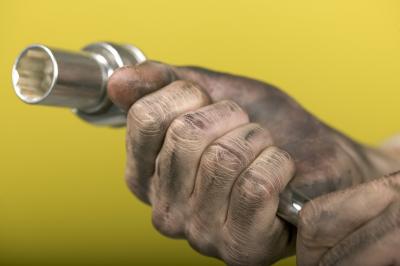
The base model version of Dodge’s 318 was equipped with a two-barrel carburetor because most consumers were not very interested in horsepower, and because a four-barrel carburetor uses more fuel. For those who own a two-barrel 318 and are interested in a performance upgrade, equipping the engine with a four-barrel carburetor is a good place to start. Upgrading to a four-barrel carburetor is simple a matter of changing the stock intake manifold to a four-barrel intake manifold.
The upper radiator hose must be removed from the front of the intake manifold. To prevent radiator fluid from draining onto the engine when the hose is removed, drain the radiator first. The short hose that leads from the top of the water pump to the front of the intake manifold must also be removed. At the front of the passenger’s side of the intake manifold is a small wire. This wire is used to send an electronic signal to the temperature gauge within the instrument panel. Pull the wire off of the intake manifold. Although the carburetor can be removed, doing so is optional and probably not necessary (since the two-barrel carburetor will not be used with the four-barrel intake manifold). Removing the distributor is not required but can make installing the four-barrel intake manifold much easier because of the additional room. If the distributor is removed, make a note of which spark plug wire attaches to which terminal on top of the distributor cap before removing the distributor to avoid any later confusion. Twelve retaining bolts, six on each side, hold the intake manifold to the cylinder heads. After removing the bolts, lift the intake manifold off of the engine.
The most important part of installing the four-barrel intake manifold is ensuring that the gasket surfaces between the manifold and the cylinder heads are clean. Use either the blade of a standard screwdriver or a gasket scraper to remove any old gasket debris from the cylinder heads, but take care not to gouge the cylinder heads with the edge of either tool. Use only new intake manifold gaskets and quality gasket sealer. Place the gaskets onto the cylinder heads, then lower the intake manifold onto the gaskets slowly to avoid inadvertently shifting the gaskets. If the distributor was removed, reinstall it before the carburetor so that the carburetor does not get in the way. Before positioning the carburetor onto the intake manifold, place a new carburetor gasket onto the manifold. Do not use gasket sealer on this gasket.
Three components must be removed from the old intake manifold: the first is the bracket for the carburetor’s throttle return spring; the second is the temperature gauge sending unit from which the single wire was removed at the front of the intake manifold on the passenger’s side; the final component is the thermostat housing. The thermostat housing is connected to the upper radiator hose; when the thermostat housing is removed, the thermostat will be revealed. If the thermostat was in working condition, it may be reused, although this would be a good opportunity to install a new one. Install these three components onto the new manifold. Install both the upper radiator hose and the short hose from the water pump must onto the new manifold. Fill the radiator with antifreeze, and wait at least two hours for the gasket sealer to dry before starting the engine.